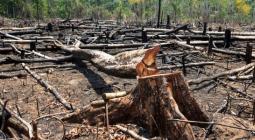It is 100 days until Cop15 – and the omens are good for a global plan to protect nature

Despite many challenges, December’s crucial biodiversity talks in Montreal may set a new path for humans to live with nature
They are known as “the twins”, born in 1992 at the Earth Summit in Rio de Janeiro but diplomatically separated and left to develop at different speeds. One is the UN’s climate change convention, or UNFCCC, now a fully fledged global agreement with huge annual summits attended by heads of state and rock stars pledging to reduce emissions.
The other, the UN convention on biological diversity (CBD), aims to protect the world’s 10 million species of animals and plants, but it meets less often, is modest by comparison, and has yet to make its mark with the public in the same way as climate.
This year, for the first time the “big brother” climate meeting, Cop27, and the “little brother” nature meeting, Cop15, will converge within days of each other before Christmas, albeit 5,600 miles apart, in Egypt and Canada. Both will attract thousands of delegates, lobbyists and non-government groups and there is much optimism that a good result in one will improve the chances of success in the other.
But there are also fears that with an escalating global energy and inflation crisis, the war in Ukraine, and superpower tensions growing – as well as the World Cup football tournament taking place in Qatar at the same time – the twin engines of global environmental protection will lose momentum, falter and fail.
The climate talks in Sharm el-Sheikh are vital, but the stakes this year for nature protection are higher than ever. Not only will Cop15 in Montreal be the largest biodiversity meeting in a generation but after the failure of previous agreements, false starts, and delays caused by Covid 19, it also hopes to have its historic Paris 2015 moment when all countries finally agree on a plan to work together.
With mass extinction forecast, rainforests falling, pandemics, droughts and heatwaves on the rise, and seas fast depleting, a detailed action plan to protect nature is long overdue.
At best, every country will agree to a new plan to save life on Earth. Called the global biodiversity framework (GBF), it will outline what countries need to do, individually and collectively, over the next 10 years, and set targets for humanity to “live in harmony with nature” by 2050. It includes rebooting conservation by greatly expanding protected areas, phasing out billions of dollars of subsidies that harm nature, and reducing pollution.
The omens are surprisingly good. Many of the high-level intergovernmental negotiations have been completed at virtual meetings; the US and China are still talking; no countries are threatening yet to wreck an agreement; and unlike the climate talks, finance is not expected to be the ultimate roadblock.
As in the run-up to many UN climate talks, though, it is touch and go 100 days before Cop15 whether the critical, “nitty gritty” technical agreements will be reached without a fatal watering-down of ambition.
An advance pre-Cop meeting should iron out many of the outstanding problems. However, some proposals are still highly contentious. There will be squabbles and hard bargaining over genetic resources, restrictions on farming and the use of pesticides, and, as with climate, how much public money rich countries will pledge to help poorer ones.
Central to an agreement but highly sensitive is what is known as “30 x 30”, the ambitious proposal that countries agree to formally protect 30% of the Earth’s land and sea by 2030 – well beyond the 17% of land and 8% of sea that is now officially protected.
It is an eye-catching, easy-to-understand plan that has been pushed by many western conservation and wildlife groups. Scientists are adamant that increasing the area of protected land and sea offers the greatest chance for nature to recover and flourish.
However, protected areas have a long history of colonialism, violence and exploitation by conservationists and governments, and if 30 x 30 is not meticulously negotiated with strong agreements that local people will retain land tenure and be rewarded for protecting ancestral lands, it is feared that it could lead to land grabs, the persecution of environmental defenders and the eviction of many already vulnerable groups of Indigenous peoples who occupy much of the world’s most biologically rich lands.
On the one hand, say many human rights groups such as Survival International, 30 x 30 threatens to evict 300 million people by turning their ancestral lands into protected areas. On the other, say conservation groups, 30 x 30 could bring together the polarised human rights and wildlife protection agendas. Global consensus is growing that conservation is best practised by local and Indigenous peoples, who have shown over centuries that they can protect nature and resources better than anyone.
Nothing is signed or sealed yet, but because it has taken so long to bring negotiations to this point, and with the climate and nature agendas converging, an agreement is now more likely than ever. If so, it will be far from perfect, but it may just set a new path for humans to live with the rest of nature.
-
John Vidal is a former Guardian environment editor
What is Cop15 and why does it matter for all life on Earth?
cover photo: Cop15 in Montreal will be the largest biodiversity meeting in a generation – and the stakes for nature protection are higher than ever. Photograph: China News Service/Getty Images





